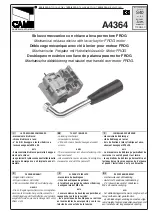
Safety Information
LSV28 S040-01M14 LF
6
© Atlas Copco Industrial Technique AB - 9836 9653 00
tection against injury. All possible hazards cannot be covered
here, but we have tried to highlight some of the important
ones.
Only qualified and trained operators should install, adjust or
use this power tool.
This tool and its accessories must not be modified in any
way.
Do not use this tool if it has been damaged.
If the rated speed, operating pressure or hazard warning signs
on the tool cease to be legible or become detached, replace
without delay.
For additional safety information consult:
• Other documents and information packed with this
tool.
• Your employer, union and / or trade association.
• “Safety Code for Portable Air Tools” (ANSI
B186.1), available at the time of printing from
Global Engineering Documents at http://
global.ihs.com/ , or call 1 800 854 7179. In case of
difficulty in obtaining ANSI standards, contact
ANSI via http://www.ansi.org/
• Further occupational health and safety information
can be obtained from the following web sites:
• http://www.osha.gov (USA)
• https://osha.europa.eu/ (Europe)
Air supply and connection hazards
• Air under pressure can cause severe injury.
• Always shut off air supply, drain hose of air pressure and
disconnect tool from air supply when not in use, before
changing accessories or when making repairs.
• Never direct air at yourself or anyone else.
• Whipping hoses can cause severe injury. Always check
for damaged or loose hoses and fittings.
• Do not use quick disconnect couplings at tool. See in-
structions for correct set up.
• Whenever universal twist couplings are used, lock pins
must be installed.
• Do not exceed maximum air pressure of 6.3 bar / 90
psig, or as stated on tool nameplate.
Entanglement hazards
• Keep away from moving sanding pad. Note that the
abrasive will continue to run after the start valve has
closed; for dual action sanders, this can last several sec-
onds.
• Choking, scalping and / or lacerations can occur if loose
clothing, gloves, jewellery, neck ware and hair are not
kept away from tool and accessories.
Projectile hazards
• Failure of the accessory or abrasive, or of the workpiece,
can generate high-velocity projectiles. Even small pro-
jectiles can injure eyes and cause blindness.
• Always wear impact-resistant eye and face protection
when involved with or near the operation, repair or
maintenance of the tool or changing accessories on the
tool.
• Be sure all others in the area are wearing impact-resis-
tant eye and face protection.
• Daily measure the speed of a rotary sander or polisher
with a tachometer to make sure that it is not greater than
the RPM marked on the backing pad, drum or abrasive.
• Ensure that the backing pad / abrasive is securely
clamped to the sander using the tools provided.
• Ensure that the workpiece is securely fixed.
Accessory hazards
• Always shut off air supply, relieve hose of air pressure
and disconnect tool from air supply when changing ac-
cessories.
• Use only recommended sizes and types of abrasives.
• Never use a backing pad, drum or abrasive with a per-
mitted speed lower than the air sander speed.
• Never mount a grinding or cutting-off wheel on a sander.
A grinding wheel that bursts can cause very serious in-
jury or death when not properly guarded.
• Use only coated abrasive sanding discs or sheets prop-
erly secured to the backing pad provided with the air
sander. Ensure that self-fixing sanding discs are mounted
concentrically.
Operating hazards
• Operators and maintenance personnel must be physically
able to handle the bulk, weight and power of the tool.
• Hold the tool correctly: be ready to counteract normal or
sudden movements – have both hands available.
• You can be cut, pinched or burned if you come into con-
tact with the sanding pad, abrasive or the work surface.
Avoid contact and wear suitable gloves to protect hands.
• Inspect backing pad before each use. Do not use if
cracked or broken, or if it has been dropped.
• Never run the tool unless the abrasive is applied to the
workpiece.
• There is a risk of electrostatic discharge if used on plas-
tic and other non-conductive materials.
• When using a tool that is designed to have a guard, the
guard should be in place to offer protection from grind-
ing swarf and other debris.
Repetitive motion hazards
• When using a power tool to perform work-related activi-
ties, the operator might experience discomfort in the
hands, arms, shoulders, neck, or other parts of the body.
• Adopt a comfortable posture whilst maintaining secure
footing and avoiding awkward or off-balance postures.
Changing posture during extended tasks can help avoid
discomfort and fatigue.
• Do not ignore symptoms such as persistent or recurring
discomfort, pain, throbbing, aching, tingling, numbness,
burning sensation, or stiffness. Stop using the tool, tell
your employer and consult a physician.
Содержание LSV28 S040-01M14 LF
Страница 135: ......







































